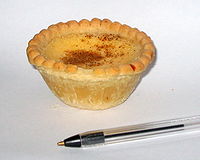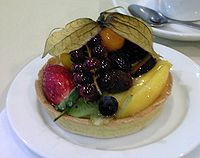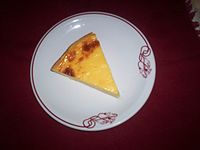- Custard tart
-
Custard tarts or flans pâtissier are a pastry consisting of an outer pastry crust filled with egg custard and baked.
Contents
History
The development of custard is so intimately connected with the custard tart or pie that the word itself comes from the old French croustade, meaning a kind of pie.[1] Some other names for varieties of custard tarts in the Middle Ages were doucettes and darioles. In 1399, the coronation banquet prepared for Henry IV included "doucettys".[2]
Medieval recipes generally included a shortcrust pastry case filled with a mixture of cream, milk, or broth with eggs, sweeteners such as sugar or honey, and sometimes spices. Recipes existed as early as the fourteenth century that would still be recognisable as custard tarts today.[3] Tarts could also be prepared with almond milk during times of fasting such as Lent, though this was rather expensive and would have been popular only with the comparatively wealthy.[4] Often, savoury ingredients such as minced pork or beef marrow were also added (the combining of sweet and savoury ingredients was more common in medieval England), but unlike a modern quiche the custard filling itself was invariably sweet.[2]
Modern versions
Modern custard tarts are usually made from shortcrust pastry, eggs, sugar, milk or cream, and vanilla, sprinkled with nutmeg and baked. Unlike egg tarts, custard tarts are normally served at room temperature. They are available either as individual tarts, generally around 8 cm (3.1 in) across, or as larger tarts intended to be divided into several slices.
Britain and Commonwealth
Custard tarts have long been a favourite pastry in the British Isles, and are also widely enjoyed in Australia and New Zealand. They are often called egg custard tarts or simply egg custards to distinguish the egg-based filling from the commonly-served cornflour-based custards. They are sold in supermarkets and bakeries throughout the UK.
In Britain, the custard tart is regarded as a classic British dish, and as such a version by Marcus Wareing was selected on the BBC television program Great British Menu as the final course of a banquet to celebrate the Queen's 80th birthday.[5]
Variations on the classic recipe include the Manchester tart, where a layer of jam is spread on the pastry before the custard is added. Other versions may have some fresh fruit, such as rhubarb cooked into the filling.[6] Versions topped with elaborate arrangements of fruit show the influence of French pâtisserie.
Hong Kong and China
Main article: egg tartCustard tarts are popular in Hong Kong and Chinese cuisine.
France
Custard tarts (flans pâtissier) in France are generally larger and shallower than British ones. The filling may contain fruit, making it similar to a clafoutis.
Portugal and Lusosphere
Main article: Pastel de nataCustard tarts are popular in the Lusosphere.
See also
References
- ^ "Custard". Oxford English Dictionary, Second Edition. Oxford University Press. 1989. http://dictionary.oed.com/cgi/entry/50056359. Retrieved 2007-12-14.
- ^ a b "Icon nominations > Egg custard tart". Icons — a portrait of England. Department for Culture, Media and Sport [1]. http://www.icons.org.uk/nom/nominations/egg-custard-custard-tart. Retrieved 2007-12-14.
- ^ Matterer, James L. (2000). "Daryols". A Boke of Gode Cookery — Medieval Recipe Translations. http://www.godecookery.com/mtrans/mtrans14.htm. Retrieved 2007-12-14.
- ^ "Baking for Britain — Custard Tarts". 2006. http://bakingforbritain.blogspot.com/2006/01/custard-tarts.html. Retrieved 2007-12-15.
- ^ "Great British Menu — The Winning Menu". 2006. http://www.bbc.co.uk/food/tv_and_radio/menu_final_winners.shtml. Retrieved 2007-12-14.
- ^ Bird, Fiona. "Recipes: Rhubarb and custard tart". Masterchef. BBC. http://www.bbc.co.uk/food/recipes/database/rhubarbandcustardtar_4934.shtml. Retrieved 2008-01-17.
External links
British pies Sweet Apple pie • Bakewell tart • Banoffee pie • Bedfordshire clanger • Black bun • Custard tart • Lemon meringue pie • Manchester tart • Mince pie • Rhubarb pie • Treacle tartSavoury Bacon and egg pie • Bedfordshire clanger • Bridie • Butter pie • Chicken and mushroom pie • Corned beef pie • Cornish pasty • Cottage pie • Cumberland pie • Curry pie • Devizes pie • Fish pie • Game pie • Homity pie • Killie pie • Meat and potato pie • Melton Mowbray pork pie • Pork pie • Scotch pie • Shepherd's Pie • Squab pie • Stargazy pie • Steak pie • Steak and kidney pie • Woolton pieManufacturers Clark's Pies • Dickinson & Morris • Fray Bentos • Ginsters • Higgidy • Holland's Pies • Mr Kipling • Peter's • Pork Farms • Pukka Pies • Shire Foods • Square Pie • Wall's • Wrights PiesCategories:- British desserts
- British pies
- Chinese dessert
- Custard desserts
- English cuisine
- French desserts
- Hong Kong cuisine
- Sweet pies
- Tarts
Wikimedia Foundation. 2010.



